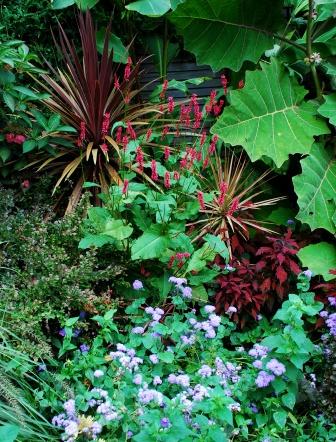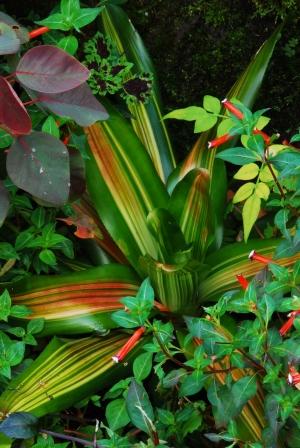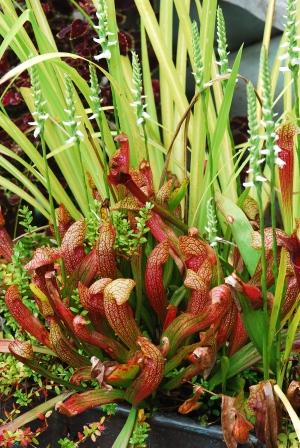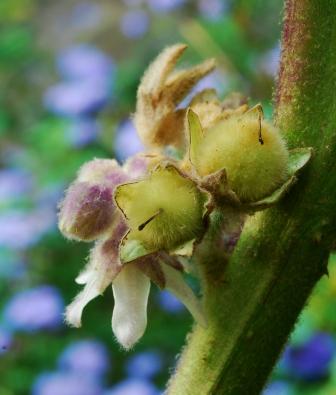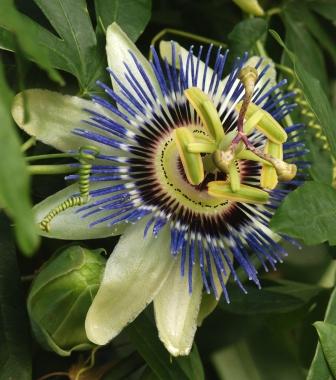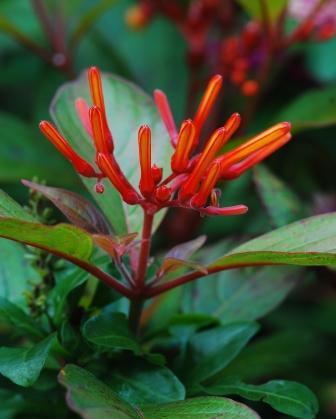October fairly well wraps up the season in my garden, but it goes out with a bang! We haven’t had a frost yet–which is odd (but I’m not complaining)-so things are looking mighty festive. Most of what’s happening is thanks to my annuals and tenders, along with a few perennials. Here’s a sampler. Above, we’ve got an eclectic combo with Ageratum ‘Blue Horizon’ and Persicaria amplexicaulis ‘Firetail’. I can never understand why this tall ageratum isn’t more common; the ‘Firetail’ often looks a bit shabby in high summer when Japanese beetles picnic upon it, but by early fall it comes back with a vengeance. For links to more Bloom Day posts, head over to May Dreams Gardens.
 I grew Cuphea ignea from seed this year so I had plenty to spread around. And I did. It consorted happily with this bromeliad, tropical smokebush (Euphorbia cotinifolia) and poet’s jasmine ‘Fiona’s Sunrise’. The cuphea happened to complement the hibiscus (var. Home Depotus) too.
I grew Cuphea ignea from seed this year so I had plenty to spread around. And I did. It consorted happily with this bromeliad, tropical smokebush (Euphorbia cotinifolia) and poet’s jasmine ‘Fiona’s Sunrise’. The cuphea happened to complement the hibiscus (var. Home Depotus) too.
Lady’s tresses (Spiranthes cernua var. odorata) is a fun late-season plant, especially when it constrasts with with these various pitcher plants and the golden blades of an iris I got from Sydney Eddison.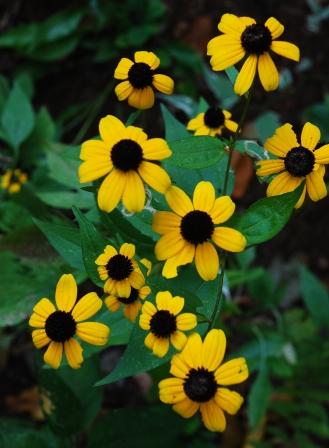
This cute brown-eyed Susan is a relative of the more common Rudbeckia fulgida ‘Goldsturm’. It’s Rudbeckia triloba, smaller and more delicate in every way. It’s a short lived perennial or biennial, and it self sows, though, as befits its other characteristics, modestly.
I’ve been ogling my Bed of Nails, no-not my existential one, the plant! Solanum quitoense is a seriously strange seed-grown specimen adorned with both soft-looking downy fuzz and lethal-looking prickers. It produces a fruit that yields a drink beloved in Colmbia and Ecuador. What’s fun are its emerging fruits and just gone-by flowers. The blue in the background is courtesy of that fine ageratum, ‘Blue Horizon’.
I’ve loved Cestrums since discovering red jasmine (Cestrum newelli ‘Elegans’) a few years back, My current favorite clan member is the fast growing hybrid Cestrum ‘Orange Peel’, which produces beauteous clusters of subtly orange-colored (not near as screaming a hue as its namesake) tubular flowers tirelessly, all season long.
Passion flowers! Their intricate architecture is endlessly fascinating. Can there be such as thing as too many?
Last, but by no means least, another little tender treasure that always catches my eye late in the season: Mexican firebush (Hamelia patens). It’s a teaser. The flowers always look as if they are about to explode, but they never do. Hummers and butterflies love it almost as muich as I do, and even birds like to snack on the black fruit it yields.

